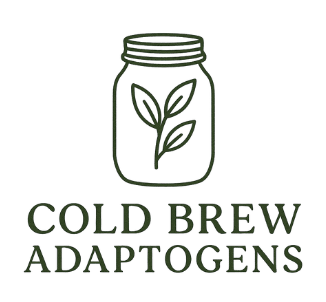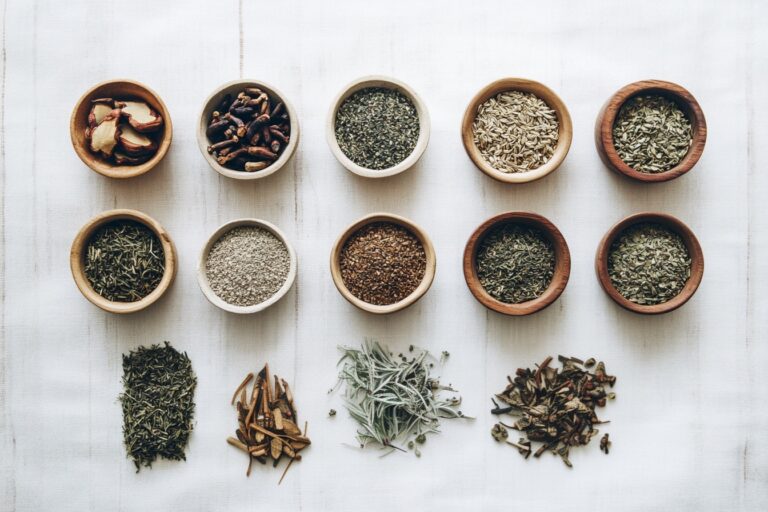Ashwagandha stands as one of the most researched and versatile adaptogens for stress relief in both traditional Ayurvedic medicine and modern wellness applications. This comprehensive ashwagandha herbal profile explores the benefits, uses, and cold brew preparation of this remarkable herb — focusing on its ability to support cortisol balance, nervous system resilience, and overall adaptogenic wellness. Whether you’re seeking natural stress management, improved sleep quality, or enhanced physical recovery, ashwagandha’s broad spectrum of benefits makes it an essential foundation herb for any adaptogenic routine.
This ancient rasayana herb adapts beautifully to modern preparation methods, with cold brewing offering a particularly gentle and refreshing approach that preserves therapeutic compounds while creating a sustainable daily practice.
Botanical Overview of Ashwagandha
Scientific Classification:
- Latin name: Withania somnifera
- Common names: Indian ginseng, winter cherry, Indian winter cherry
- Plant family: Solanaceae (nightshade family)
- Parts used: Primarily root; leaves occasionally in traditional preparations
- Native regions: India, Middle East, parts of Africa and Mediterranean
This hardy perennial shrub thrives in arid climates and poor soils, producing small greenish-yellow flowers and distinctive orange-red berries. The thick, fleshy root system contains the highest concentration of therapeutic compounds and serves as the primary source for most ashwagandha preparations. The plant’s resilience in harsh growing conditions mirrors its adaptogenic properties in supporting human stress resilience.

Active Compounds and Mechanisms
Understanding how ashwagandha works reveals why it’s a cornerstone among cortisol balance herbs and adaptogenic preparations.
Primary Bioactive Compounds:
- Withanolides: Steroidal lactones that provide ashwagandha’s primary stress-modulating effects, with withanoside VI and withanoside IV being the most studied.
- Alkaloids: Including anaferine and anahygrine, which contribute to nervous system calming effects.
- Sitoindosides: Antioxidant compounds that help reduce inflammation and support cellular protection.
Key Therapeutic Mechanisms:
- HPA Axis Regulation: Modulates hypothalamic-pituitary-adrenal axis activity to support healthier cortisol rhythms and stress response patterns.
- Nervous System Balance: Promotes calm alertness through neurotransmitter regulation without sedation or stimulation.
- Mitochondrial Support: Enhances cellular energy production and reduces oxidative stress.
- Immune Modulation: Supports balanced immune function under stress conditions.
These mechanisms make ashwagandha particularly effective as part of comprehensive adaptogens for stress reliefprotocols.
Evidence-Based Benefits
Cortisol Balance and Stress Support
Ashwagandha’s most well-documented benefit involves normalizing cortisol levels regardless of whether they’re elevated from chronic stress or suppressed due to adrenal fatigue. Clinical studies show consistent reductions in perceived stress and improvements in stress-related symptoms with regular use.
When you’re ready to learn more about the benefits of adaptogens, we have created a guide explaining how to use adaptogens to aid stress relief.
Sleep Quality Enhancement
Improves sleep onset, duration, and quality without morning grogginess or dependency. Supports natural sleep architecture rather than forcing sedation.
Physical Performance and Recovery
Enhances strength, muscle mass, and exercise recovery while reducing exercise-induced stress markers.
Cognitive Function and Mental Clarity
Supports attention, processing speed, and memory, especially under stress.
Thyroid and Metabolic Support
May support healthy thyroid function and metabolic rate — those with thyroid conditions should seek medical guidance.
Traditional and Modern Uses
- Ayurvedic Applications: Classified as a rasayana (rejuvenative tonic), traditionally prepared in warm milk with ghee and honey for vitality.
- Modern Preparations: Standardized extracts, powders, capsules, and teas.
- Cold Brewing Advantage: Preserves heat-sensitive compounds, smooth flavor, and supports warm-weather routines.
For a detailed overview of modern preparation techniques, see our Cold Brew Adaptogenic Tea Guide.

How to Make Ashwagandha Cold Brew Tea
Why Cold Brew Works Best:
- Preserves heat-sensitive with anolides.
- Reduces bitterness from tannins.
- Creates a smoother daily beverage.
- Integrates seamlessly into summer wellness routines.
Basic Method:
- Add 1 tablespoon root powder (or 2 tablespoons chopped dried root) to 2–3 cups cold filtered water.
- Steep at room temperature for 1–2 hours.
- Refrigerate 10–14 hours.
- Strain through fine mesh, then cheesecloth.
- Flavor with honey, cinnamon, or ginger if desired.
- Store refrigerated up to 3 days.
For a full recipe and flavor pairing suggestions, explore Cold Brew Ashwagandha Tea for Stress Relief & Cortisol Balance.
Safety and Usage Notes
- Avoid during pregnancy/breastfeeding unless supervised by a healthcare provider.
- Use caution with autoimmune conditions or thyroid medications.
- May have mild blood pressure-lowering effects.
- Consider cycling (5 days on / 2 days off) or rotating every 4–6 weeks.
FAQ
How long before I notice results?
Calming effects may be felt within days; full adaptogenic benefits usually take 4–8 weeks.
Can I combine ashwagandha with other herbs?
Yes — it works well with tulsi, lemon balm, and reishi. Start with one herb to gauge effects. For more on combinations, we go into more detail in Combining Adaptogens for Nervous System Support.
Is cold brew as effective as hot tea?
Yes — it retains delicate compounds and is easier to consume daily due to smoother flavor.
Summary
Ashwagandha’s unique combination of stress-modulating withanolides, nervous-system-calming alkaloids, and antioxidant compounds makes it a foundational adaptogen for modern wellness. Whether taken as a traditional hot tonic or a refreshing cold brew, it offers a versatile, safe, and effective path toward cortisol balance, stress resilience, and overall vitality.


